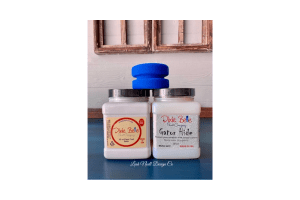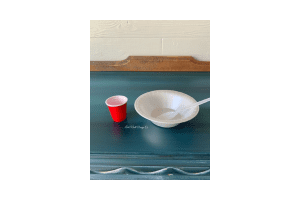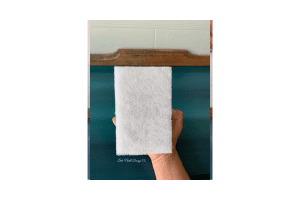You have no items in your cart.
How do you get a nice smooth furniture paint finish on the top of your furniture? If you’ve ever painted furniture, you know the top is the most important part! It also is one of the hardest areas to get a smooth and durable finish. The larger the area, the more room there is to make mistakes, but it is important to seal the top of your furniture because it gets the most use! I’m here to give you a few tips on how to get a smooth painted top that is sealed for durability.
This post contains affiliate links. You don’t pay any more from ordering from these links but I earn a small commission so I can continue to bring you more fun projects! They also allow me to show you exactly what I use so you know what I’m referring to!
Material List:
- Paint
- Clear Satin
- Gator Hide
- Blue Sponge
- Finishing Pad
- Dish Soap
- Foam Bowl
- Spoon
These directions are intended for applying a protective top coat after using chalk paint.
My chalk paint of choice is Dixie Belle Paint because it is self leveling and dries evenly, which make it easier to paint and topcoat!
So you’ve painted your entire piece of furniture and now you want to apply your top coat. First, make sure your paint is dry. I usually let my last coat of paint dry for at least 2 hours before applying a top coat.
Here is where I do something a little differently than most painters: I like to use 2 different types of topcoat. I use Clear Satin and Gator Hide. Why do I do it this way? I’ve found that the Clear Satin is a little thicker than the Gator Hide so it dries slower. This gives me more working time to allow the clear satin to absorb into the chalk paint. In turn, I’ve found this makes the Gator Hide go on a lot easier.

To start, I grab a small bowl, plastic spoon (or this fancy plastic shot glass from the dollar store), and my Clear Satin. I stir the Clear Satin with the plastic spoon. Always stir your top coat; when you shake your top coat instead of stirring, you create air bubbles in the product which will lead to unwanted bubbles on your finish. Once the top coat is stirred, I scoop it out with the spoon or the disposable shot glass into the bowl. I don’t pour the Clear Satin into the bowl because it will pick up any residue on the rim of the jar. I always transfer it into a bowl so I can avoid getting paint into my jar of clear satin or gator hide.

Then, I apply it with the Blue Sponge. I get the blue spoinge damp, but not wet. I start about 6 inches in from the edge and pull the sponge in one direction. I start 6 inches in so I don’t have drips down the side from starting the top coat on the edge. I pull the Clear Satin in one direction with even pressure across the whole piece. If I start on the right end of the piece, I begin each new stroke on the right end of the piece– avoid going in a back and forth motion. Wash your blue sponge out with hot water and dish soap between each application. Do not store it in a baggie.
Once the Clear Satin is dry (it should take about an hour, depending on your weather conditions), I lightly rub over it once with a finishing pad (like the one shown below) to remove any debris. Then I apply a second coat of Clear Satin. I use this finishing pad after each coat of sealer.

Now it is time for the Gator hide! Gator Hide is heat and water resistant so it is SUPER durable. I use it on all my tops. Gator Hide works best when it is slightly above room temperature, so I like to let the container sit in a bowl of warm (not hot) water for about 10 minutes before I use it. Then I use it the exact same way I used the Clear Coat. You can apply 1-3 coats of Gator Hide. I don’t recommend applying more than 3 coats. The more you build it up, the more chances you have for streaks. Some streaks are okay! It is just the nature of doing it by hand. Let your top coat cure for at least 7 days for light use and 30 for full use.
I hope these instructions were helpful for applying a topcoat to chalk paint by hand. I’ve always said one of the reasons I was attracted to Dixie Belle is because their topcoats are durable and easy to use, but you can also use this process with other brands of chalk paints.